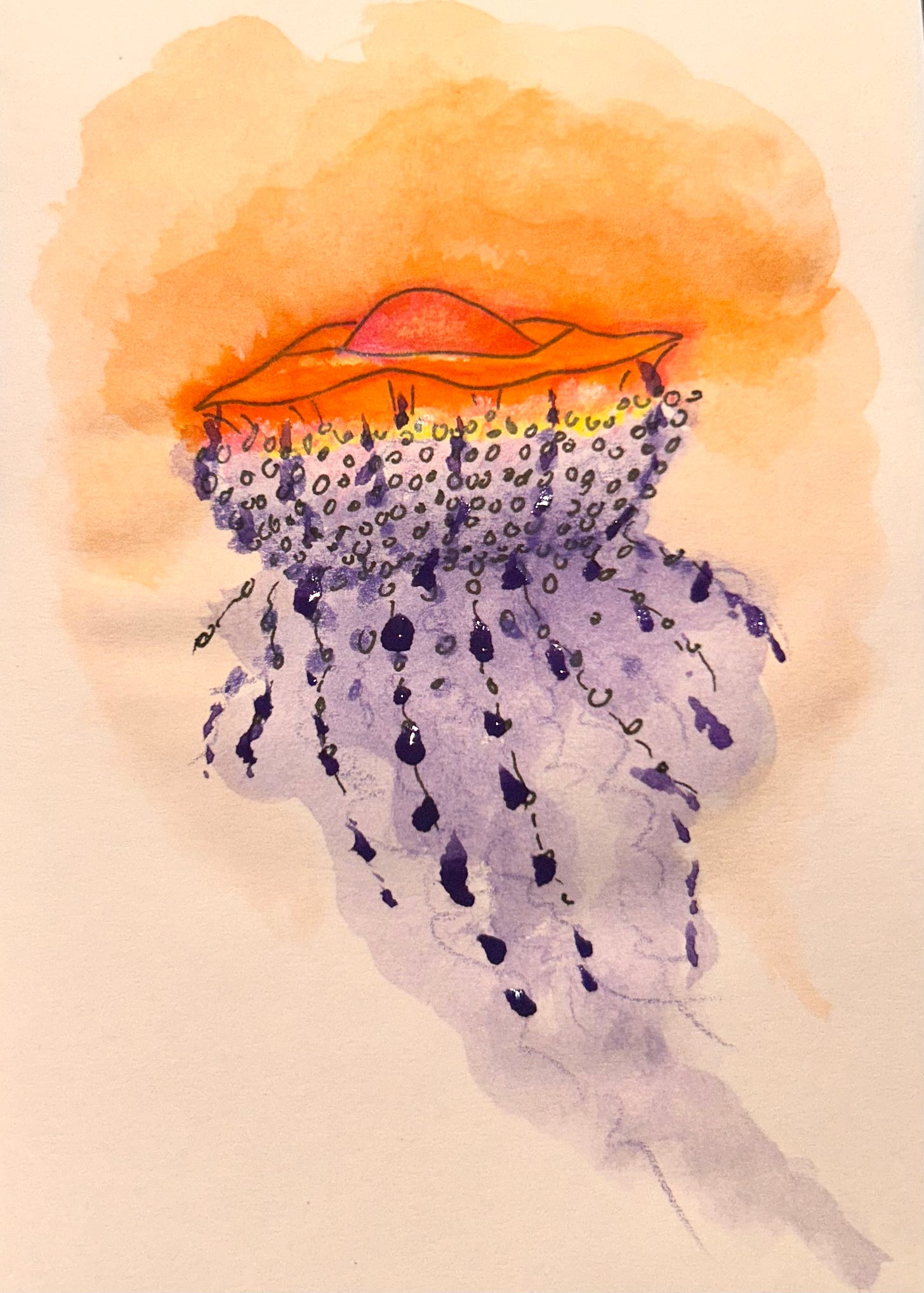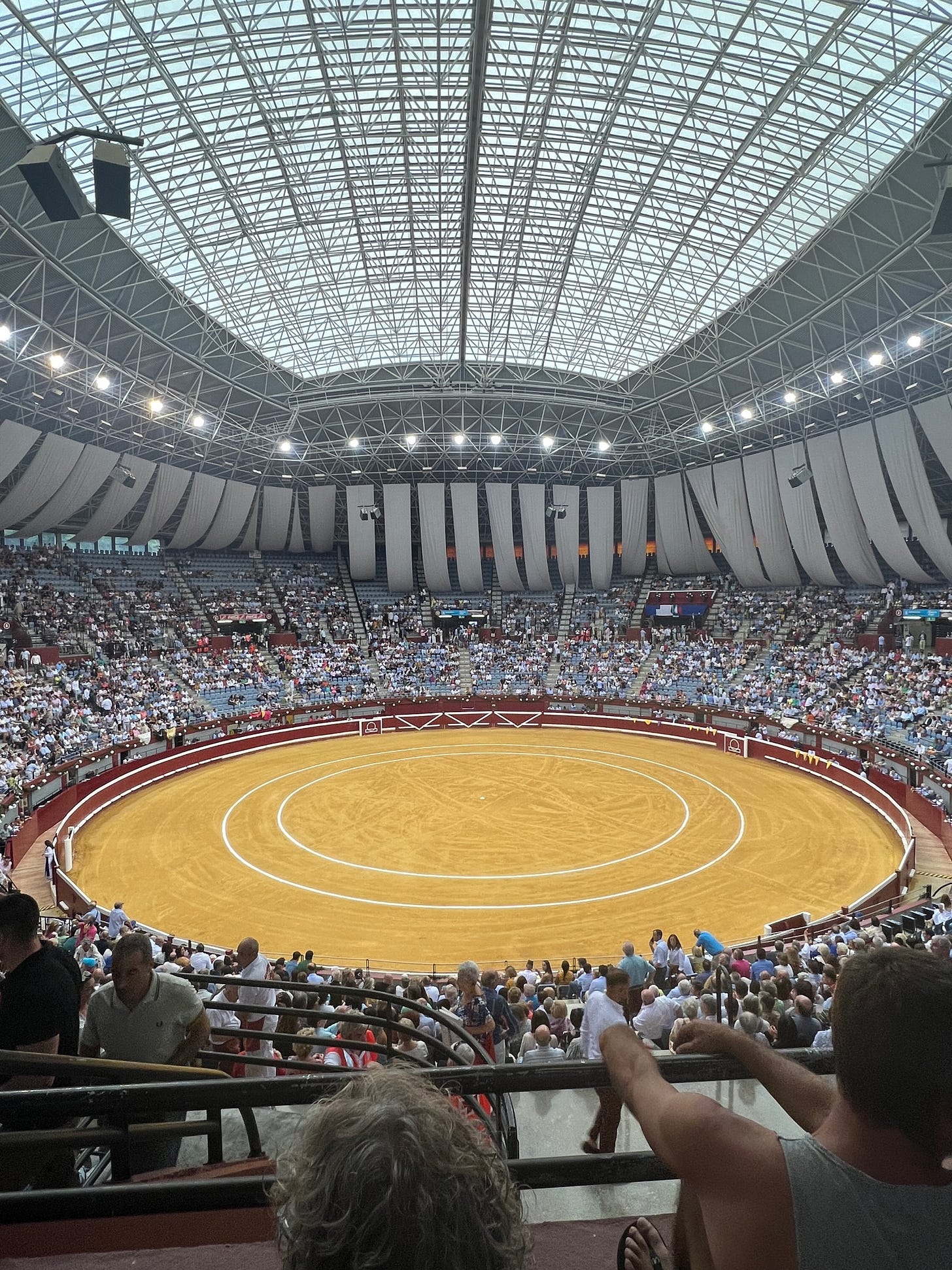Welcome new subscribers. If you came here via my recent stories this is pretty different and potentially upsetting.
***
Pamplona
The air in a closed bullfighting ring is very bad, boiling hot and fetid with animal shit. My sister, next to me, looks uncomfortable.
What? Nothing. What? Nothing.
Finally she leans over and whispers: Does the bull die?
Obviously the bull dies! I feel that this shouldn’t be news at this point, but now I’m uneasy, remembering—too late—how she faints at the sight of blood.
Backstage, the bulls are being harassed for pretty much the first time in their lives, which they’ve spent nicely on rambling estates just for fighting cattle. There they were provoked—tested on aggressiveness—but nothing like what is happening now (branding) or is about to happen (death.)
Oliverero, five years old, 285 kilos, clatters into the arena, snorting and steaming, giant dick swinging. In part one he’s lanced by two men on horseback. The spears hang in his rump like heavy darts, or else fall, peeling off strips of skin. Next, three men harpoon him in the neck. There’s so much blood that the yellow sand turns pink, and my sister, who once collapsed over a paper cut, looks extremely miserable.
Now enters the matador, who is supposed to stay as near to the bull as possible without being skewered. This one is so close he keeps spanking it, which I feel is excessive. He has ten minutes to kill and is supposed to do it in one thrust, but that doesn’t usually happen; instead, the rapier slices through the lungs, so that blood bubbles out of the animal’s mouth and nose.
This happens to Oliverero, who pauses for a long time, trembling and drooling, before his knees buckle. When he falls the crowd goes berserk. The rest is perfunctory: The bull is stabbed in the brain with a short knife, tied up by the horns, and dragged out of the arena while the brass band plays.
The bodies are sold to vendors. Most of it—besides the balls, blood, and tail—is too tough to eat, though chefs have been trying, for years, to sell it as haute cuisine. The eight countries in which bullfighting is legal kill a quarter million bulls each year; where it is illegal, there are workarounds: Americans swap out lances for suction cups, and the French (gracefully?) leap over the pinioned bull.
In match four a matador is gored. He does an airborne summersault, held aloft by one bull horn, which is burrowed into his right thigh. I decide it’s time for us to leave but later read that he had the wound sutured, and returned to kill the bull. Pride, or bills? Top matadors, who train for a minimum of seven years, make over $100,000 per match.
There are female bullfighters, but not many. ''We women toreras have two problems,'' one told the Times in the eighties. ''The bulls, and the men. Frankly, the men are more difficult.''
***
San Sebastián
There’s a café here called The Yellow Deli. The service is attentive—they ply me with free juice and vomity papaya smoothies, and the host, a young man with a ponytail and wistful gray eyes, always says Welcome with unusual gravity, like I’m someone very special.
I figure it’s all a pick-up, but one day we go for lunch and he asks where we’re from. He gets excited when we say New York—there are three Yellow Delis there. He hands me a map. Indeed there are, though in peculiar, rural locations. The deli’s reach is astonishing: they are in Japan, North and South America, Australia, and all over Europe.
Jay, a businessman, is impressed. You’re a franchise? he asks. We take care of each other, says the host. In fact, he continues, it’s the Yellow Deli’s 50th anniversary! With a flourish, he furnishes us with three pamphlets.
My sister, who doesn’t read much, is absorbed by the pamphlet. Over her shoulder, I see that it’s mostly full of scripture. Jay leaves for the bathroom and doesn’t come back for a long time. I search yellow deli on Google, only to find that here, deep in the bowels of the café, there is no WiFi.
We are given bowls of chili we didn’t ask for. I’m suspicious now, but the chili is distracting—it’s so delicious I forget about the weirdness and gobble it up. Soon after we pay and leave, discussing the wonderful chili on our way out.
I was so preoccupied I only recently remembered to finish my search, and was not disappointed—The Yellow Deli is famously the purse of the Twelve Tribes, a global Christian fundamentalist cult.
***
Barcelona
At an old hotel on Tibidabo. It used to be fancy but is now pretty dusty, so dusty that Jay, who I suspect booked it to propose, does not.
It’s clearly floating on past accolades. Hemingway stayed here while writing one of his Spanish books, as well as the Obamas on a recent vacation. Do we know of the Obamas? asks the manager. Sure, we’ve heard of them. Well, you’ll be in their suite, he says. I wonder if they tell this to all of the Americans.
Regardless, Jay is excited. I am too, until I learn that the hotel was converted into a hospital during the Spanish Civil War, and that hundreds of soldiers died here. Here, in the hotel, but also in this particular suite, since it’s in the northeast corner with a good breeze for the sick and wounded.
I’m not usually so uneasy about ghosts. The problem is the hotel’s proximity to a theme park. It has one long, rickety roller coaster, and from it comes scream after blood-curdling scream, very late into the night.
***
Deià
There is a jellyfish infestation here. There are dozens in the water, pulsing merrily, like little floating hamburgers. They’re called ‘fried egg jellyfish’ and look horrifically poisonous, but their stings are gentle, so much so that I don’t notice I’m swimming amongst them, killing myself, until a frantic Spanish lady pulls me out of the water. Big medusa, she says, blowing out her cheeks and holding her hands in a donut shape. Big medusa.
This is on the northern coast of Mallorca, in the sea around a village famous for once being the Mediterranean's largest artist colony. Its leader was the poet Robert Graves, who claimed that the mountains, veined with iron ore, created a magnetic field that made people creative. Unfortunately, the colony and the magnetic field were destroyed when Richard Branson razed the mountain to build a giant luxury hotel that was then sold to Bernard Arnault.
Awesome, says Jay.
Shame! says I.
My sister shrugs, and gestures to the view—terraced olive groves, gold brick houses, a gauzy blue sea. I don’t know, she says. If I lived here, I would also be a poet.
Postscript
On food. San Sebastián is famous for it. You can muscle your way into any pintxos bar and scream your order out and eat something amazing. Here are my recommendations: Casa Urola (tartare and foie gras), Ganbara (mushroom + egg dish, tomato salad), and Bar Nestor, which serves two of its famous tortillas a day, and is first come first serve. De Moniö is the best place to eat in Deià.
On accomodations. Northern Mallorca has rocky but less crowded and very beautiful beaches. El Moli is fine; the main thing is their shuttle, which takes you to a private beach at the bottom of the mountains. La Florida in Barcelona if you’re into ghosts and big pools. An excellent Airbnb in San Sebastián’s old town.
On activities. In San Sebastián, swim at La Concha and surf at Zurriola (a good surf school.) Barcelona was gripped by a heatwave so I spent most days at this bookstore, where you should read The Sun Also Rises and this masterpiece series by Carlos Ruiz Zafón.







I get errors when I try to subscribe. Is this a restricted substack?